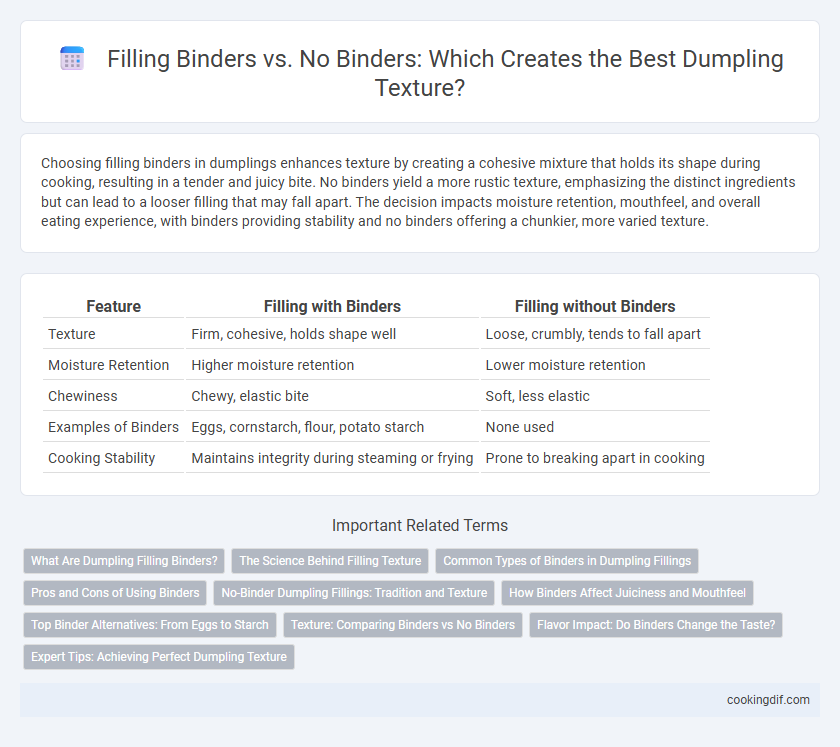Choosing filling binders in dumplings enhances texture by creating a cohesive mixture that holds its shape during cooking, resulting in a tender and juicy bite. No binders yield a more rustic texture, emphasizing the distinct ingredients but can lead to a looser filling that may fall apart. The decision impacts moisture retention, mouthfeel, and overall eating experience, with binders providing stability and no binders offering a chunkier, more varied texture.
Table of Comparison
| Feature | Filling with Binders | Filling without Binders |
|---|---|---|
| Texture | Firm, cohesive, holds shape well | Loose, crumbly, tends to fall apart |
| Moisture Retention | Higher moisture retention | Lower moisture retention |
| Chewiness | Chewy, elastic bite | Soft, less elastic |
| Examples of Binders | Eggs, cornstarch, flour, potato starch | None used |
| Cooking Stability | Maintains integrity during steaming or frying | Prone to breaking apart in cooking |
What Are Dumpling Filling Binders?
Dumpling filling binders are ingredients like eggs, cornstarch, or flour that help hold the filling together, creating a cohesive texture and preventing it from becoming too watery or crumbly during cooking. Fillings with binders tend to have a firmer, more uniform consistency, which enhances the overall mouthfeel and keeps the dumpling intact when steamed or boiled. In contrast, fillings without binders rely solely on the natural moisture and fat content, resulting in a looser, more tender texture that can sometimes cause the dumpling to be more delicate or prone to breaking.
The Science Behind Filling Texture
Filling binders such as starch, egg, or tofu proteins play a crucial role in achieving a cohesive and tender dumpling texture by enhancing moisture retention and structural integrity. Without binders, fillings may become crumbly or release excess water during cooking, negatively affecting the dumpling's mouthfeel. Scientific studies reveal that binders interact with meat proteins and water molecules, creating a gel matrix that balances firmness and juiciness in the final product.
Common Types of Binders in Dumpling Fillings
Common binders in dumpling fillings include egg, cornstarch, and breadcrumbs, each contributing to a cohesive texture by holding ingredients together during cooking. Egg provides a rich, slightly firm structure ideal for meat-based fillings, while cornstarch offers a light, gelatinous bind that enhances moisture retention without altering flavor. Breadcrumbs absorb excess liquids, creating a firmer, less sticky filling preferred in vegetable or mixed dumplings where maintaining distinct texture is essential.
Pros and Cons of Using Binders
Using binders in dumpling fillings, such as eggs, breadcrumbs, or starches, helps improve texture by providing cohesion and preventing ingredients from separating during cooking, resulting in a firmer and more uniform bite. However, binders can sometimes dilute the natural flavors of the filling and create a heavier, less delicate texture that some diners may find less appealing. Opting for no binders maintains a purer, more robust taste and a lighter mouthfeel, but risks crumblier, less stable fillings that may fall apart during steaming or frying.
No-Binder Dumpling Fillings: Tradition and Texture
No-binder dumpling fillings preserve the natural texture of ingredients, offering a traditional eating experience with a tender yet distinct bite. Without binders like starch or egg, the filling maintains moisture while showcasing individual flavors and textures, such as minced pork or finely chopped vegetables. This method emphasizes authenticity and freshness, delivering a dumpling with a more artisanal and rustic mouthfeel.
How Binders Affect Juiciness and Mouthfeel
Binders like cornstarch or breadcrumbs in dumpling fillings improve texture by retaining moisture, enhancing juiciness, and preventing the filling from becoming dry or crumbly during cooking. Without binders, fillings tend to release more liquid, resulting in a wetter texture that can make the dumpling wrapper soggy and diminish the desired mouthfeel. The choice and amount of binder directly influence the balance between a tender, juicy bite and a firm, cohesive filling, impacting overall dumpling quality.
Top Binder Alternatives: From Eggs to Starch
Filling binders in dumplings, such as eggs, cornstarch, and potato starch, create a cohesive texture by holding meat and vegetable mixtures together, preventing separation during cooking. No binder fillings typically rely on high-protein or fatty ingredients to naturally bind the mixture, resulting in a looser, more rustic texture. Top binder alternatives including tapioca starch and wheat gluten offer plant-based options that enhance chewiness and moisture retention without altering flavor.
Texture: Comparing Binders vs No Binders
Fillers such as eggs, breadcrumbs, or cornstarch act as binding agents that create a firmer, more cohesive dumpling texture while maintaining moisture. Without binders, the filling tends to be looser and softer, resulting in a more delicate, less structured bite. Texture varies significantly depending on the presence of binders, influencing the overall mouthfeel and structural integrity during cooking.
Flavor Impact: Do Binders Change the Taste?
Filling binders such as eggs, breadcrumbs, or tofu influence dumpling texture by adding moisture retention and structural integrity without significantly altering the core flavors of meat or vegetable fillings. The omission of binders results in a purer taste profile, allowing the natural ingredients to dominate with a lighter, more delicate mouthfeel. Binders primarily affect texture and juiciness, while the seasoning and freshness of the ingredients determine the overall flavor impact in the dumpling.
Expert Tips: Achieving Perfect Dumpling Texture
Using binding agents such as cornstarch or egg not only helps retain moisture but also creates a firmer, more cohesive filling that holds its shape during steaming or frying. Avoiding binders results in a looser texture, allowing the natural ingredients like minced pork or vegetables to shine with a juicier bite. Expert dumpling chefs recommend balancing binder quantity based on filling moisture to achieve the ideal combination of tenderness and structure.
Filling binders vs No binders for texture Infographic

 cookingdif.com
cookingdif.com